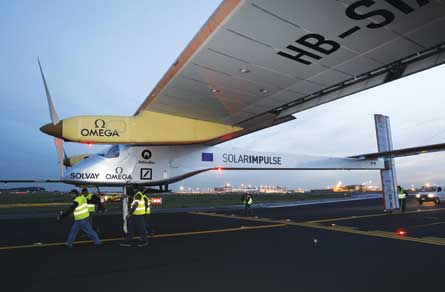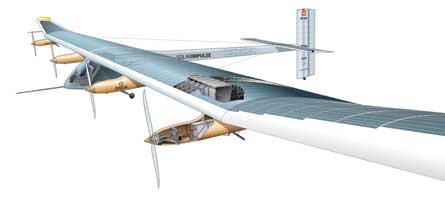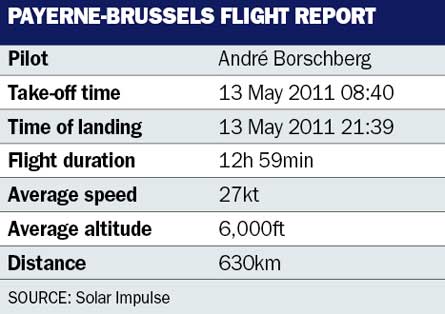Solar Impulse hopes to wow the crowds at the Paris air show with flying displays of its solar-powered aircraft, after confidence was boosted by the prototype's first international flight in May.
However, the plan is dependent on the right weather conditions - first for the aircraft to depart Brussels Zaventem for Paris Le Bourget, and then for daily flights during the show.
The Swiss company's HB-SIA prototype, billed as the Paris air show's "special guest", will be taking part in flying displays each morning during the show, weather permitting.
The team behind prototype HB-SIA - led by Solar Impulse chief executive André Borschberg and co-founder Bertrand Piccard - will be keeping their fingers crossed for a repeat of the circumstances that enabled the Brussels flight.
In that flight, the aircraft took off from Payerne air base in Switzerland at 08:40 local time on 13 May, piloted by Borschberg, and landed nearly 13h later in the Belgian capital.
 |
|---|
© Rex |
Solar Impulse's first international flight landed at Brussels Zaventem on 13 May |
Borschberg describes the cruise flight as "very smooth", after a tricky pre-flight phase as he found himself sandwiched between fog on the ground and heavy traffic in the surrounding area due to a NATO exercise. "I had to do the preparation work in the air instead of on the ground," says Borschberg. But in the end a "beautiful flight" led the aircraft to collect more energy than the batteries could store.
Borschberg took advantage of a clear spell to make the flight happen. "The day before it was very stormy and the day after was planned to be stormy, so we had a nice window."
HB-SIA reached an altitude of flight level 120 during the flight. Its route took it across the Alsace region of France towards Nancy and Metz before it crossed Luxembourg and landed on Brussels Zaventem airport's Runway 02.
"We want to demonstrate that we can fly from one city to another," says Borschberg, explaining that part of the reason the flight took almost 13h was because "we have to take off early in the morning to have good weather, and we have to land late in the evening when air traffic control calms down".
The Brussels flight proved that "despite the fact that it's a prototype, it can really fly to a destination and the technology really works".
As he stepped out of the cockpit on to the tarmac in Brussels, Borschberg told the gathered group of supporters: "It's unbelievably exciting to land here in Brussels, at the heart of Europe, after flying across France and Luxembourg. And to fly without fuel, noise or pollution, making practically no negative impact, is a great source of satisfaction."
 |
|---|
See it for yourself at Paris - weather permitting |
The Solar Impulse team then spent a week displaying the prototype and promoting the use of renewable energy to representatives of various Brussels-based European institutions.
HB-SIA is a four-engined, carbonfibre aircraft with a 64.3m (211ft) wingspan, the same as an Airbus A340's. It weighs in at 1,600kg (3,525lb) - similar to an average family car. The 12,000 solar panels built into its wings charge 400kg of lithium polymer batteries during the day, allowing it to continue flying at night.
 |
|---|
It has taken a team of 70 people and 80 partners, including main sponsors Solvay, Omega, Deutsche Bank and Schindler, seven years of research and development to reach this point. But the company's ambitions are broader than using the power of the Sun to fly from one European city to another. It is already working on a bigger aircraft, which it plans to operate either across the Atlantic or around the world in 2014.
"We haven't decided [which] yet, it's too early to make that decision," says Borschberg. Test flights with the second prototype, HB-SIB, are expected to begin in 2013. "We never had the intention to make a longer flight with the original prototype, but it works so well that you can fly for longer [than expected]," he says.
HB-SIA is not equipped to fly over oceans, which is why a second prototype is under development. HB-SIB will include an autopilot and a different cockpit, to be more comfortable for the pilot. However, Solar Impulse says it will not have a pressurised cockpit, so its maximum altitude will remain unchanged at 29,500ft. The second prototype's wingspan has not been determined yet. Solar Impulse envisages that a round-the-world flight would take around 20 days, with about five stops.
Beyond this, Solar Impulse could develop a third prototype, with space for two pilots. "If we find a partner interested in pursuing the adventure, we can imagine maybe a third prototype with two seats, to attempt a non-stop flight around the world," it says.
Borschberg hopes that while the aircraft "doesn't carry passengers, it carries a message". And that message is to show that innovation and technology can help to shape a sustainable future.
Source: Flight International



















